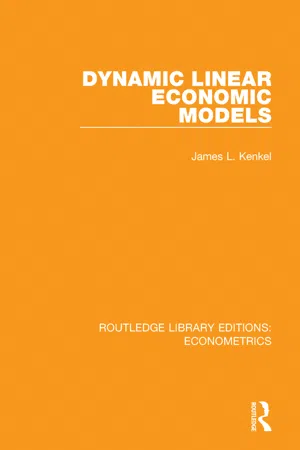
This is a test
- 396 pages
- English
- ePUB (mobile friendly)
- Available on iOS & Android
eBook - ePub
Dynamic Linear Economic Models
Book details
Book preview
Table of contents
Citations
About This Book
Originally published in 1974. This book provides a rigorous and detailed introductory treatment of the theory of difference equations and their applications in the construction and analysis of dynamic economic models. It explains the theory of linear difference equations and various types of dynamic economic models are then analysed. Including plenty of examples of application throughout the text, it will be of use to those working in macroeconomics and econometrics.
Frequently asked questions
At the moment all of our mobile-responsive ePub books are available to download via the app. Most of our PDFs are also available to download and we're working on making the final remaining ones downloadable now. Learn more here.
Both plans give you full access to the library and all of Perlego’s features. The only differences are the price and subscription period: With the annual plan you’ll save around 30% compared to 12 months on the monthly plan.
We are an online textbook subscription service, where you can get access to an entire online library for less than the price of a single book per month. With over 1 million books across 1000+ topics, we’ve got you covered! Learn more here.
Look out for the read-aloud symbol on your next book to see if you can listen to it. The read-aloud tool reads text aloud for you, highlighting the text as it is being read. You can pause it, speed it up and slow it down. Learn more here.
Yes, you can access Dynamic Linear Economic Models by James L. Kenkel in PDF and/or ePUB format, as well as other popular books in Business & Business General. We have over one million books available in our catalogue for you to explore.
Chapter 1
Mathematical Preliminaries
1.1 Complex Numbers
In our analysis of difference equations we shall have to deal with various types of equations whose solutions cannot be found if we restrict our solutions to the set of real numbers. In order to avoid this problem we extend the number system to include complex numbers.
First we outline a list which comprises what is called the real number system. The natural numbers 1, 2, 3, 4, … are the same as the set of positive integers. To the set of natural numbers, we add the set of negative integers and zero (-1, -2, -3, …) and 0. The set of rational numbers or fractions is the set of numbers which can be written as a/b where b ≠ 0 and where a and b are positive or negative integers or a is zero. The set of irrational numbers is the set of numbers such as
which are expressible in terms of an infinite number of decimals but which cannot be expressed in the form a/b where a and b are integers. The set of rational and irrational numbers is called the set of real numbers. It is assumed that the student is already familiar with these ideas and with the various operations which can be performed on real numbers. For a more detailed treatment he should consult any text on real analysis.
Any real number can be represented by a point on a line called a real axis, as indicated below in Figure 1. The choice of origin and the unit length are completely arbitrary.

Figure 1
Once we have chosen an origin and a unit length, then to each real number there is one and only one point on the real axis and to each point on the real axis there corresponds one and only one real number. The absolute value of a real number a, d...
Table of contents
- Cover
- Half Title
- Title Page
- Copyright Page
- Table of Contents
- CHAPTER 1 MATHEMATICAL PRELIMINARIES
- CHAPTER 2 INTRODUCTION TO DIFFERENCE EQUATIONS
- CHAPTER 3 GENERAL THEORY OF LINEAR DIFFERENCE EQUATIONS
- CHAPTER 4 LINEAR HOMOGENEOUS DIFFERENCE EQUATIONS WITH CONSTANT COEFFICIENTS
- CHAPTER 5 PARTICULAR SOLUTIONS
- CHAPTER 6 SOLVING LINEAR DIFFERENCE EQUATIONS USING OPERATORS
- CHAPTER 7 EQUILIBRIUM AND STABILITY
- CHAPTER 8 SYSTEMS OF DIFFERENCE EQUATIONS
- CHAPTER 9 DISTRIBUTED LAGS
- CHAPTER 10 ANALYSIS OF ACCELERATOR MODELS
- CHAPTER 11 LINEAR DYNAMIC ECONOMIC MODELS
- CHAPTER 12 THE CYCLIC PROPERTIES OF THE LINEAR MODEL
- CHAPTER 13 INTRODUCTION TO OPTIMAL CONTROL
- CHAPTER 14 FORECASTING WITH AUTOREGRESSIVE MODELS
- BIBLIOGRAPHY
- INDEX